Module 1 British and American English教案
文档属性
| 名称 | Module 1 British and American English教案 |
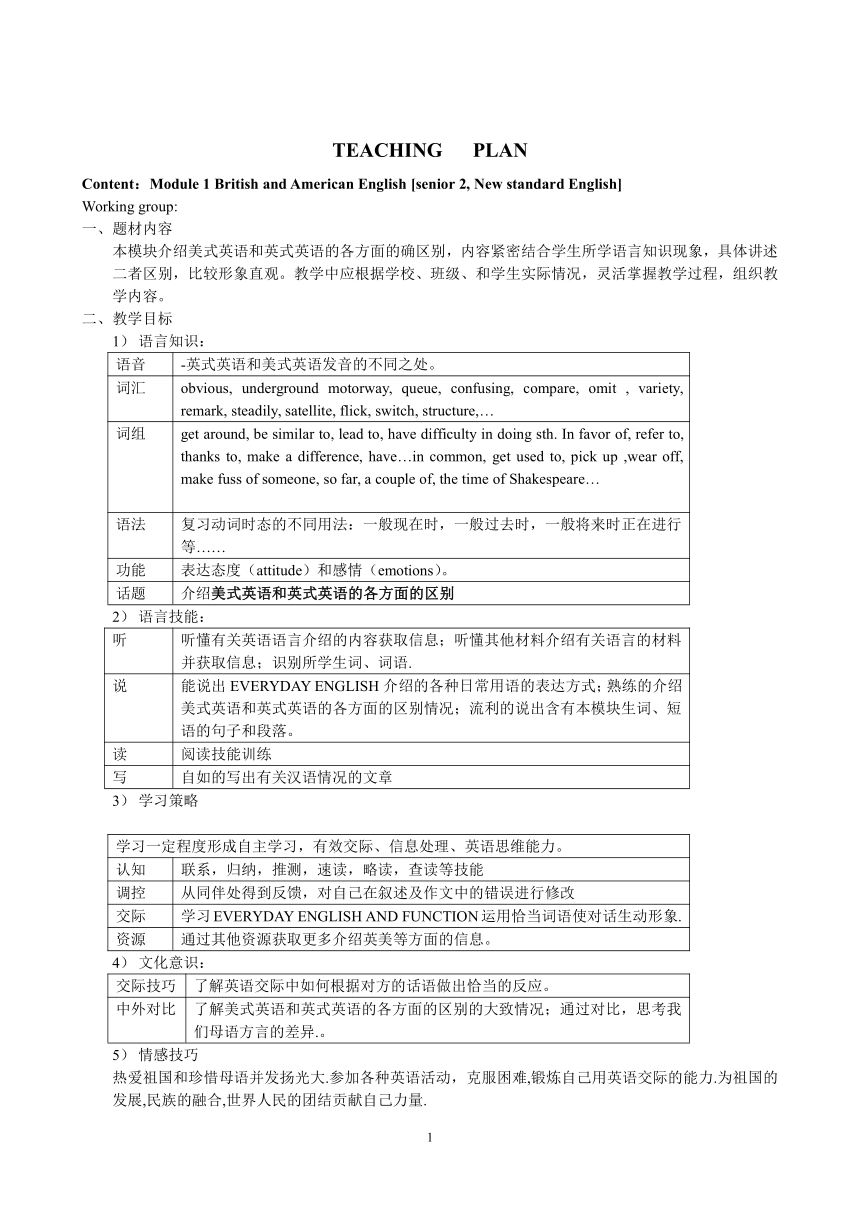
|
|
| 格式 | zip | ||
| 文件大小 | 22.1KB | ||
| 资源类型 | 教案 | ||
| 版本资源 | 外研版 | ||
| 科目 | 英语 | ||
| 更新时间 | 2011-10-12 12:33:51 | ||
图片预览

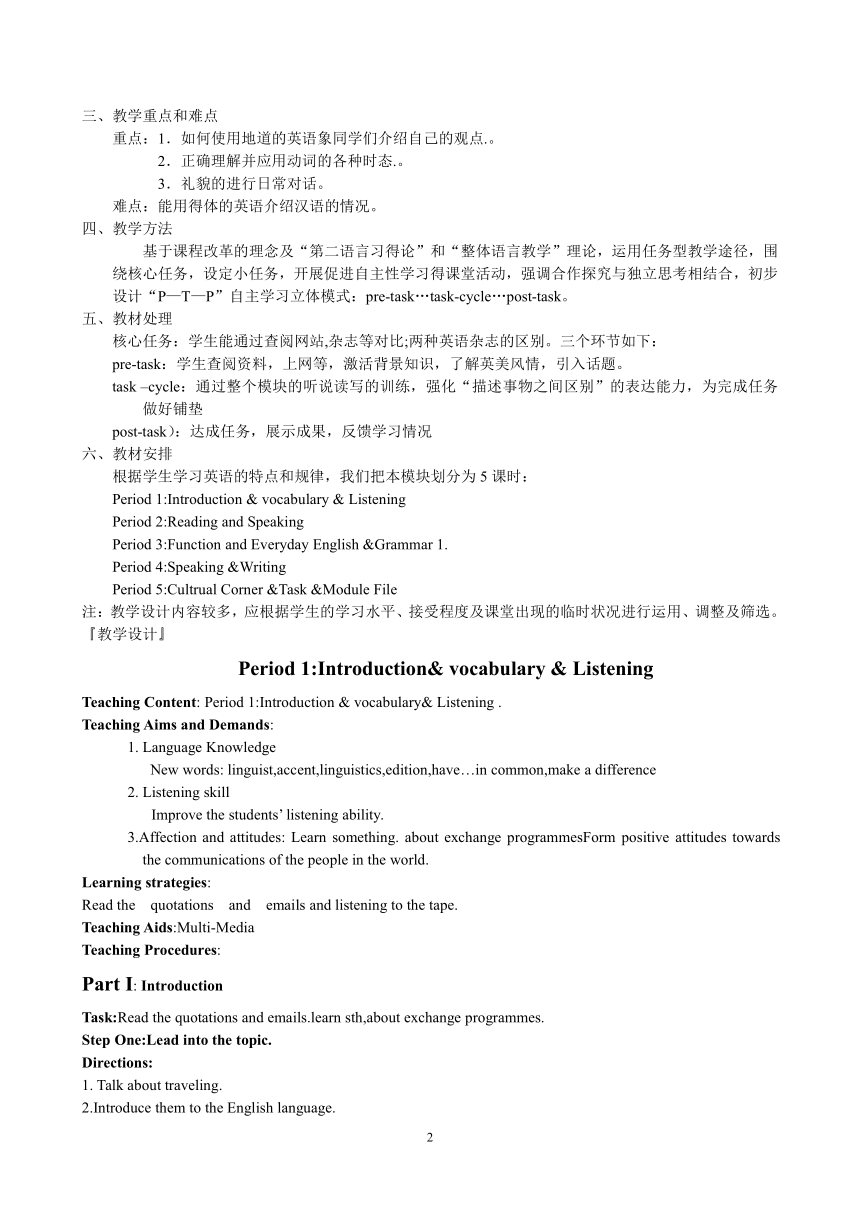
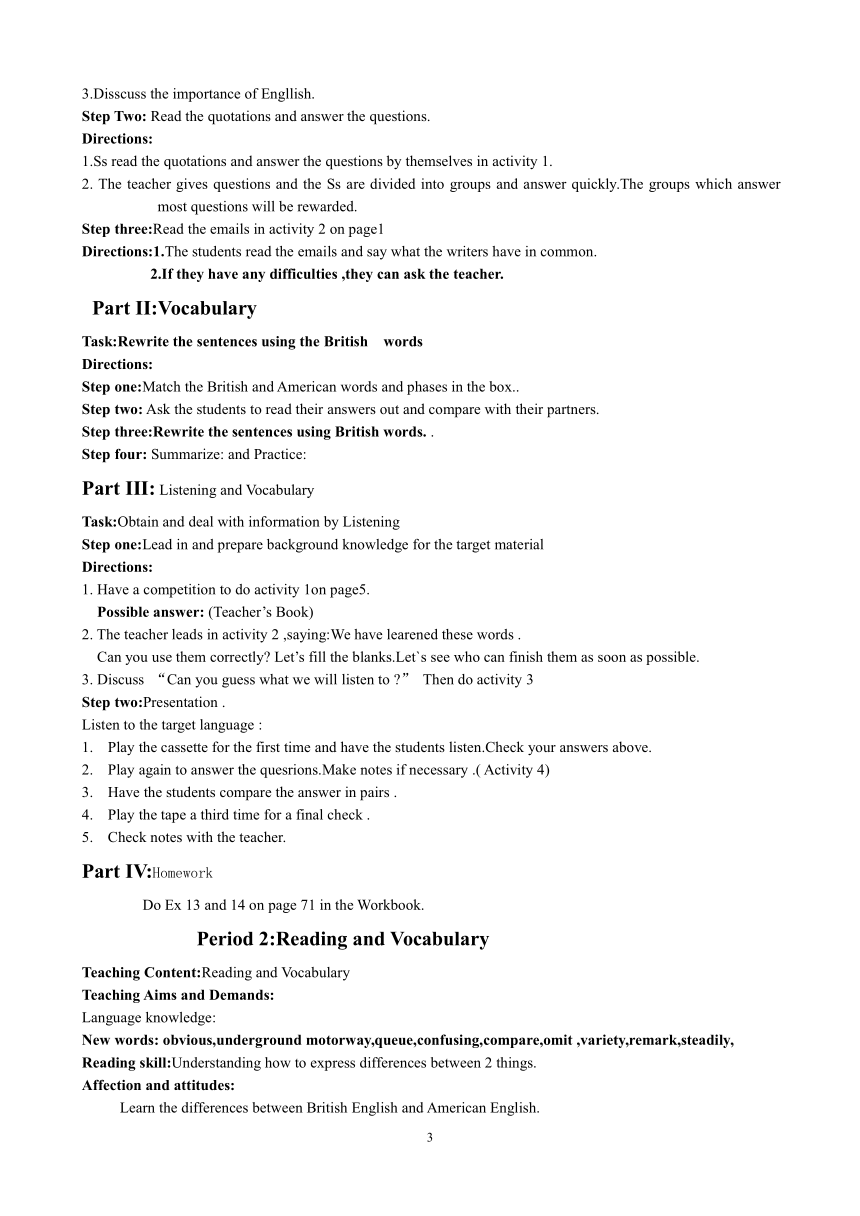
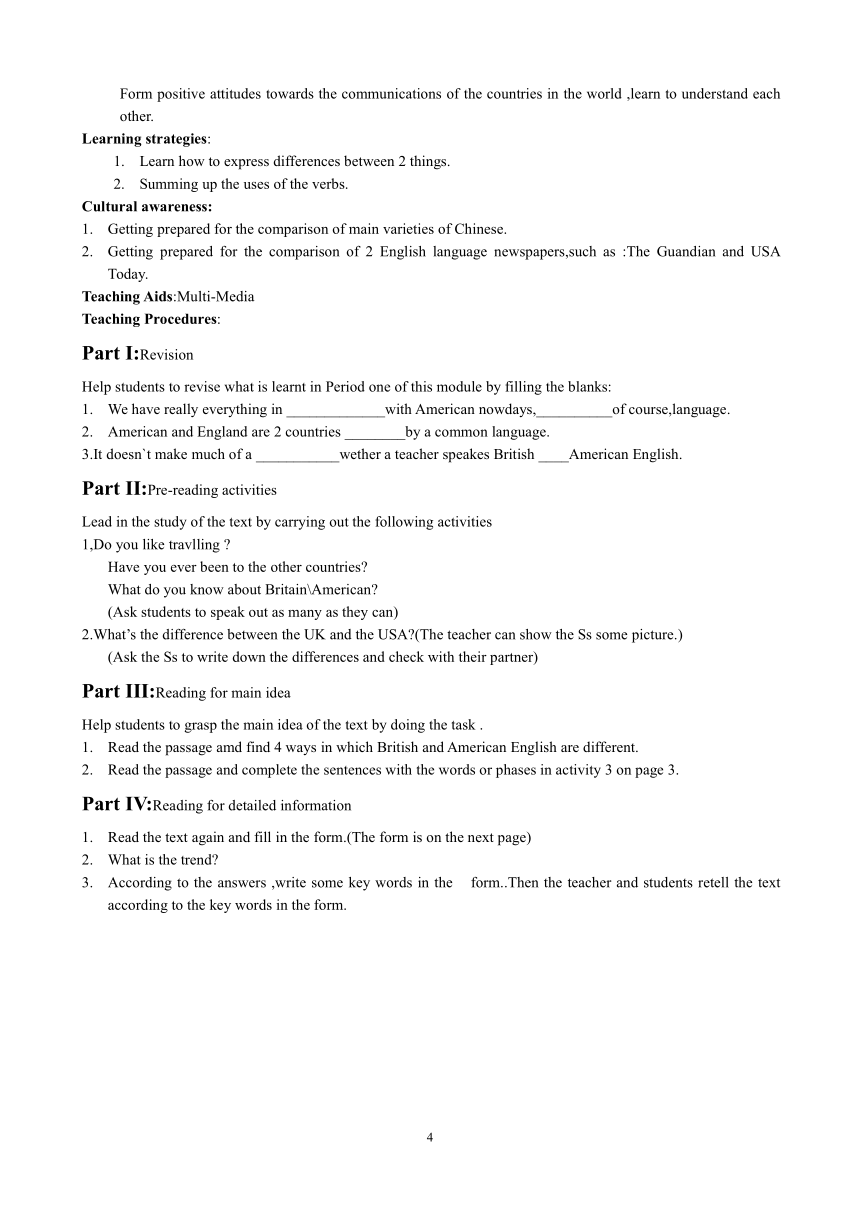
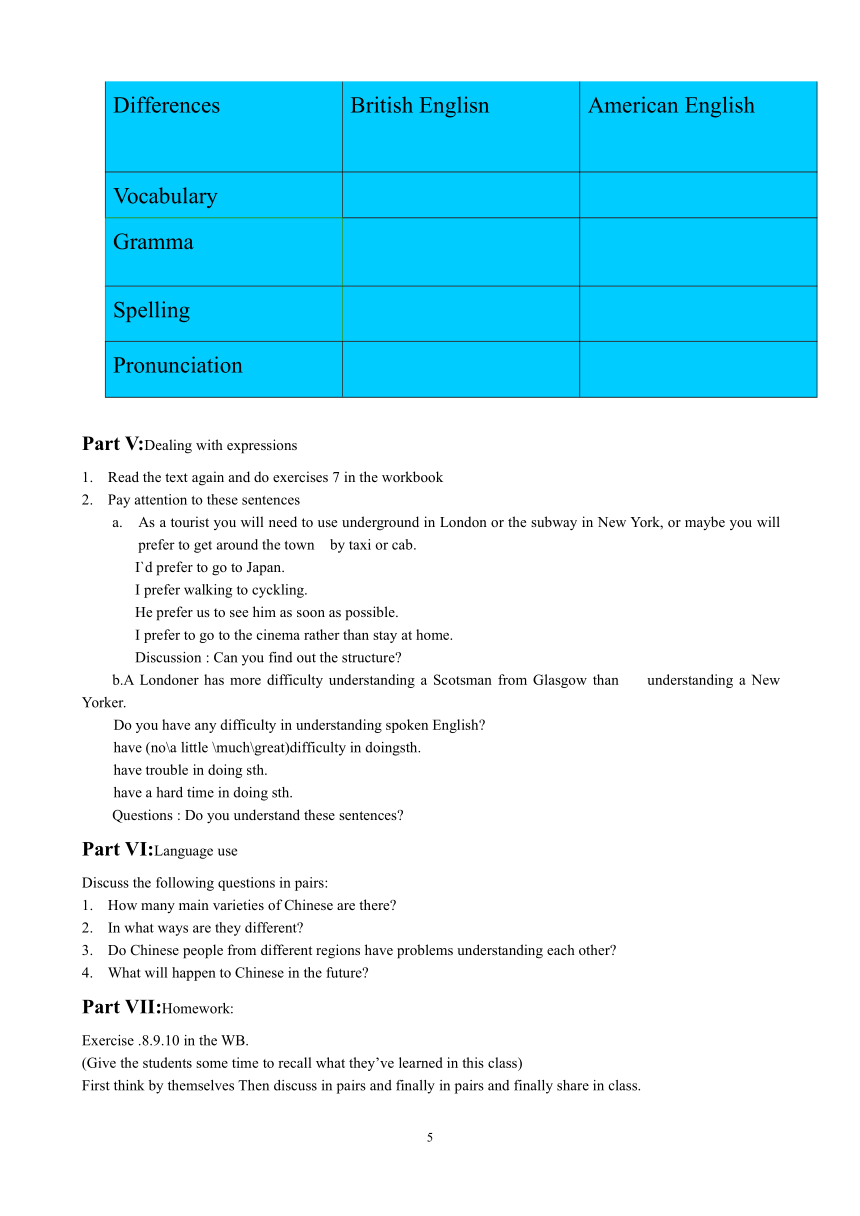
文档简介
TEACHING PLAN
Content:Module 1 British and American English [senior 2, New standard English]
Working group:
题材内容
本模块介绍美式英语和英式英语的各方面的确区别,内容紧密结合学生所学语言知识现象,具体讲述二者区别,比较形象直观。教学中应根据学校、班级、和学生实际情况,灵活掌握教学过程,组织教学内容。
教学目标
语言知识:
语音 -英式英语和美式英语发音的不同之处。
词汇 obvious, underground motorway, queue, confusing, compare, omit , variety, remark, steadily, satellite, flick, switch, structure,…
词组 get around, be similar to, lead to, have difficulty in doing sth. In favor of, refer to, thanks to, make a difference, have…in common, get used to, pick up ,wear off, make fuss of someone, so far, a couple of, the time of Shakespeare…
语法 复习动词时态的不同用法:一般现在时,一般过去时,一般将来时正在进行等……
功能 表达态度(attitude)和感情(emotions)。
话题 介绍美式英语和英式英语的各方面的区别
语言技能:
听 听懂有关英语语言介绍的内容获取信息;听懂其他材料介绍有关语言的材料并获取信息;识别所学生词、词语.
说 能说出EVERYDAY ENGLISH介绍的各种日常用语的表达方式;熟练的介绍美式英语和英式英语的各方面的区别情况;流利的说出含有本模块生词、短语的句子和段落。
读 阅读技能训练
写 自如的写出有关汉语情况的文章
学习策略
学习一定程度形成自主学习,有效交际、信息处理、英语思维能力。
认知 联系,归纳,推测,速读,略读,查读等技能
调控 从同伴处得到反馈,对自己在叙述及作文中的错误进行修改
交际 学习EVERYDAY ENGLISH AND FUNCTION运用恰当词语使对话生动形象.
资源 通过其他资源获取更多介绍英美等方面的信息。
文化意识:
交际技巧 了解英语交际中如何根据对方的话语做出恰当的反应。
中外对比 了解美式英语和英式英语的各方面的区别的大致情况;通过对比,思考我们母语方言的差异.。
情感技巧
热爱祖国和珍惜母语并发扬光大.参加各种英语活动,克服困难,锻炼自己用英语交际的能力.为祖国的发展,民族的融合,世界人民的团结贡献自己力量.
教学重点和难点
重点:1.如何使用地道的英语象同学们介绍自己的观点.。
2.正确理解并应用动词的各种时态.。
3.礼貌的进行日常对话。
难点:能用得体的英语介绍汉语的情况。
教学方法
基于课程改革的理念及“第二语言习得论”和“整体语言教学”理论,运用任务型教学途径,围绕核心任务,设定小任务,开展促进自主性学习得课堂活动,强调合作探究与独立思考相结合,初步设计“P—T—P”自主学习立体模式:pre-task…task-cycle…post-task。
教材处理
核心任务:学生能通过查阅网站,杂志等对比;两种英语杂志的区别。三个环节如下:
pre-task:学生查阅资料,上网等,激活背景知识,了解英美风情,引入话题。
task –cycle:通过整个模块的听说读写的训练,强化“描述事物之间区别”的表达能力,为完成任务做好铺垫
post-task):达成任务,展示成果,反馈学习情况
教材安排
根据学生学习英语的特点和规律,我们把本模块划分为5课时:
Period 1:Introduction & vocabulary & Listening
Period 2:Reading and Speaking
Period 3:Function and Everyday English &Grammar 1.
Period 4:Speaking &Writing
Period 5:Cultrual Corner &Task &Module File
注:教学设计内容较多,应根据学生的学、接受程度及课堂出现的临时状况进行运用、调整及筛选。
『教学设计』
Period 1:Introduction& vocabulary & Listening
Teaching Content: Period 1:Introduction & vocabulary& Listening .
Teaching Aims and Demands:
1. Language Knowledge
New words: linguist,accent,linguistics,edition,have…in common,make a difference
2. Listening skill
Improve the students’ listening ability.
3.Affection and attitudes: Learn something. about exchange programmesForm positive attitudes towards the communications of the people in the world.
Learning strategies:
Read the quotations and emails and listening to the tape.
Teaching Aids:Multi-Media
Teaching Procedures:
Part I: Introduction
Task:Read the quotations and emails.learn sth,about exchange programmes.
Step One:Lead into the topic.
Directions:
1. Talk about traveling.
2.Introduce them to the English language.
3.Disscuss the importance of Engllish.
Step Two: Read the quotations and answer the questions.
Directions:
1.Ss read the quotations and answer the questions by themselves in activity 1.
2. The teacher gives questions and the Ss are divided into groups and answer quickly.The groups which answer most questions will be rewarded.
Step three:Read the emails in activity 2 on page1
Directions:1.The students read the emails and say what the writers have in common.
2.If they have any difficulties ,they can ask the teacher.
Part II:Vocabulary
Task:Rewrite the sentences using the British words
Directions:
Step one:Match the British and American words and phases in the box..
Step two: Ask the students to read their answers out and compare with their partners.
Step three:Rewrite the sentences using British words. .
Step four: Summarize: and Practice:
Part III: Listening and Vocabulary
Task:Obtain and deal with information by Listening
Step one:Lead in and prepare background knowledge for the target material
Directions:
1. Have a competition to do activity 1on page5.
Possible answer: (Teacher’s Book)
2. The teacher leads in activity 2 ,saying:We have learened these words .
Can you use them correctly Let’s fill the blanks.Let`s see who can finish them as soon as possible.
3. Discuss “Can you guess what we will listen to ” Then do activity 3
Step two:Presentation .
Listen to the target language :
Play the cassette for the first time and have the students listen.Check your answers above.
Play again to answer the quesrions.Make notes if necessary .( Activity 4)
Have the students compare the answer in pairs .
Play the tape a third time for a final check .
Check notes with the teacher.
Part IV:Homework
Do Ex 13 and 14 on page 71 in the Workbook.
Period 2:Reading and Vocabulary
Teaching Content:Reading and Vocabulary
Teaching Aims and Demands:
Language knowledge:
New words: obvious,underground motorway,queue,confusing,compare,omit ,variety,remark,steadily,
Reading skill:Understanding how to express differences between 2 things.
Affection and attitudes:
Learn the differences between British English and American English.
Form positive attitudes towards the communications of the countries in the world ,learn to understand each other.
Learning strategies:
Learn how to express differences between 2 things.
Summing up the uses of the verbs.
Cultural awareness:
Getting prepared for the comparison of main varieties of Chinese.
Getting prepared for the comparison of 2 English language newspapers,such as :The Guandian and USA Today.
Teaching Aids:Multi-Media
Teaching Procedures:
Part I:Revision
Help students to revise what is learnt in Period one of this module by filling the blanks:
We have really everything in _____________with American nowdays,__________of course,language.
American and England are 2 countries ________by a common language.
3.It doesn`t make much of a ___________wether a teacher speakes British ____American English.
Part II:Pre-reading activities
Lead in the study of the text by carrying out the following activities
1,Do you like travlling
Have you ever been to the other countries
What do you know about Britain\American
(Ask students to speak out as many as they can)
2.What’s the difference between the UK and the USA (The teacher can show the Ss some picture.)
(Ask the Ss to write down the differences and check with their partner)
Part III:Reading for main idea
Help students to grasp the main idea of the text by doing the task .
Read the passage amd find 4 ways in which British and American English are different.
Read the passage and complete the sentences with the words or phases in activity 3 on page 3.
Part IV:Reading for detailed information
Read the text again and fill in the form.(The form is on the next page)
What is the trend
According to the answers ,write some key words in the form..Then the teacher and students retell the text according to the key words in the form.
Differences British Englisn American English
Vocabulary
Gramma
Spelling
Pronunciation
Part V:Dealing with expressions
Read the text again and do exercises 7 in the workbook
Pay attention to these sentences
As a tourist you will need to use underground in London or the subway in New York, or maybe you will prefer to get around the town by taxi or cab.
I`d prefer to go to Japan.
I prefer walking to cyckling.
He prefer us to see him as soon as possible.
I prefer to go to the cinema rather than stay at home.
Discussion : Can you find out the structure
b.A Londoner has more difficulty understanding a Scotsman from Glasgow than understanding a New Yorker.
Do you have any difficulty in understanding spoken English
have (no\a little \much\great)difficulty in doingsth.
have trouble in doing sth.
have a hard time in doing sth.
Questions : Do you understand these sentences
Part VI:Language use
Discuss the following questions in pairs:
How many main varieties of Chinese are there
In what ways are they different
Do Chinese people from different regions have problems understanding each other
What will happen to Chinese in the future
Part VII:Homework:
Exercise .8.9.10 in the WB.
(Give the students some time to recall what they’ve learned in this class)
First think by themselves Then discuss in pairs and finally in pairs and finally share in class.
Part VIII:A test
Retell the text.
Period 3: Grammar 1& Function and Everyday English
Teaching Content: Grammar 1& Function and Everyday English
Teaching Aims and Demands: Master the grammar and use them freely
Affection and attitudes: Learn the differences between British English and American English.
Form positive attitudes towards the communications of the countries in the world ,learn to understand each other.
Learning strategies:
Learn how to express one’s opinion using the phrases that we have learned.
Summing up the uses of the verbs.
Cultural awareness:
1.Getting prepared for the comparison of main varieties of Chinese.
2.Getting prepared for the comparison of 2 English language newspapers,such as :The Guandian and USA Today.
Teaching Aids:Multi-Media
Teaching Procedures:
Part I:Grammar 1
Task 1:Find out the uses of the verbs. rules of the tenses
Activity 1. Match the sentences with the correct meanings.
Activity2:complete the sentences with the correct form of the verbs.
Activity3:Tell the uses of the verbs. rules of the tenses
Complete the sentences in your own words.
Observe, compare and find out the rules.
【NMET.2001】:I____ping-pang quite well, but I haven’t had time to play since the new year .
A will play B have played C played D play
【北京春招2000】:_You’re drinking too much.
_Only at home .No one ________me but you.
is seeing B had seen C sees D saw
The Present Simple Tense
The Present Continuous Tense
The Presen Perfect Tense
The Simple Past Tense
The Future Tense
Part III:Everyday English
Task:Use the phrases freely.
Directions:
Step one:
Remind the students of the expressions that we have learned.
Step two:Ask the students to remember them .
Step three:Speaking practice:
Have a conversation using some of the phrases.
Part IV:Function
Task: Giving reasons
Directions:
Step one:Underline the words which introduce reasons.
Step two:Answer the questions.
Step three:complete the sentences with because\since\as or now that.
Part V: A test
Complete the messages with the correct form of the verbs.
Hi Mum,
Hope you__________(be) well.I ________(have) a lovely time in New York.Tomorrow we___________ (go) to see the fireworks.It`s hard to understand the accent here,but it ________(get) easier ,as I _________(be) here for 3 weeks. Next week we _________(fly) to Mexico where they ________(speak) no English at all,just Spanish.I __________(Spend) nearly all the money you gave me!
Love ,Xiao Ping
Part V:Homework:
Do EX 1、2、3.4 on Page 67 in the workbook.
Period 4 :Speaking &Writing
Teaching Content: Speaking &Writing
Teaching Aims and Demands: Master the sentence patterns and use them freely
Speaking skill : Learn how to comkpare 2 things.
Teaching Procedures:
Part I::Speaking
Task: P resent your ideas about the comparison of different varieties of English
Direction:
Step one: I can lead in saying” what have you learned ”
What’s the topic (Give them the topic) Present your ideas about the comparison of different varieties of English
Step two:
1) List the words which may be used for this topic.
2) Students may make some sentences about this topic using the words.
3) Translate some sentences which are all about the topic .
Give them some suggestions.
Thus they will form a passage.
4) Ask and answer questions about the passage.
Step three:Talk about the similarities or differences about different varieties of English
Using the passage as a model.
Step four:Now vote for the variety of English you think is best to learn.
Part II: Writing
Task: White 3 more paragraphs about the Chinese language..
Step one:Lead in choosing the best title for the paragraph.
Can you say sth.more about the Chinese language.
Step two:Give the Ss some topics as paragraph headings and ask them to White 3 more paragraphs about the Chinese language.
(Pay attention to the sentence patterns)
Step three: ____Evaluation by oneself & partner
Step four: ____Read it out before the class.
Part III:Recalling
Recall what we learn today.
Part IV:Homework: Composition
Do EX 17 on Page 72 in the workbook.
Period 5: Cultrual Corner &Task &Module File
Teaching Content: Cultrual Corner &Task &Module File
Teaching Aims and Demands: Master the sentence patterns and use them freely
Teaching Procedures:
Part I: Cultural corner
Task:Read the passage.
Directions:
Step one:Lead in saying“We have learnt the differences between British English and American English .Have you master them . Do you know other things about English ”Now read the letter.
Step two:Students read through the passage and answer the questions:
What reasons did Websster have for writing an American dictionary
Can you see any similarities between Webster`s work and attempts to simplify Chinese
PartII: Module File
Step one: Key words form vocabulary:
1.variety
There are many varieties of roses in our garden.
a variety of = various
There are various fishes in the deep ocean.
2.compare
compare A with B
compare A to B
compare with \to
If you compare this thing with that thing, you will find many differences.
He compare his shoes to small boats.
His work doesn`t compare with yours.
(2004年湖北考题)___________with the size of the whole earth ,the biggest ocean does not seem big at all.
Compare
When comparing
Comparing
When sompared
3。queu
jump the queu
stand in a queu =stand in line
A number of people are queuing up to buy the Haier fridge.
There are a long queue outside the canteen.
4. adopt
adopt a resolution
adopt a child
As they haven`t a child of their own,they are going to ___________a little child.
A .adopt
B adapt
C.ccept
D .receive.
bination
combine vt.
combine with
be combined in
be combined with
Step two:words to revise
floor
the ground floor the first floor
floor price
floor an examination paper
On which floor do you live
garbage
garbage can
household garbage
fall
a sharp fall of temperature
Fall behind
Fall in ,men!
Fall out ,men!
Night falls.
----It`s weeks since he___________.
----So it is. We`d better ask someone else to help us.
fell in
was ill
is ill
has been ill
Step three:Key Phrases
be similar to
get around
have difficulty in doing
have …in common
in favour of
lead to
make a sifference
refer to…as…
thanks to
Step four:Key patterns:
Have you got…
Do you have…
Americans use a flashlight ,while for the British,it`s a torch.
How are you getting on
British and American English are different in many ways.
Part III:Recalling
Recall what we learned today.
Part IV:Homework Recite the phrases and sentence patterns .
PAGE
2
Content:Module 1 British and American English [senior 2, New standard English]
Working group:
题材内容
本模块介绍美式英语和英式英语的各方面的确区别,内容紧密结合学生所学语言知识现象,具体讲述二者区别,比较形象直观。教学中应根据学校、班级、和学生实际情况,灵活掌握教学过程,组织教学内容。
教学目标
语言知识:
语音 -英式英语和美式英语发音的不同之处。
词汇 obvious, underground motorway, queue, confusing, compare, omit , variety, remark, steadily, satellite, flick, switch, structure,…
词组 get around, be similar to, lead to, have difficulty in doing sth. In favor of, refer to, thanks to, make a difference, have…in common, get used to, pick up ,wear off, make fuss of someone, so far, a couple of, the time of Shakespeare…
语法 复习动词时态的不同用法:一般现在时,一般过去时,一般将来时正在进行等……
功能 表达态度(attitude)和感情(emotions)。
话题 介绍美式英语和英式英语的各方面的区别
语言技能:
听 听懂有关英语语言介绍的内容获取信息;听懂其他材料介绍有关语言的材料并获取信息;识别所学生词、词语.
说 能说出EVERYDAY ENGLISH介绍的各种日常用语的表达方式;熟练的介绍美式英语和英式英语的各方面的区别情况;流利的说出含有本模块生词、短语的句子和段落。
读 阅读技能训练
写 自如的写出有关汉语情况的文章
学习策略
学习一定程度形成自主学习,有效交际、信息处理、英语思维能力。
认知 联系,归纳,推测,速读,略读,查读等技能
调控 从同伴处得到反馈,对自己在叙述及作文中的错误进行修改
交际 学习EVERYDAY ENGLISH AND FUNCTION运用恰当词语使对话生动形象.
资源 通过其他资源获取更多介绍英美等方面的信息。
文化意识:
交际技巧 了解英语交际中如何根据对方的话语做出恰当的反应。
中外对比 了解美式英语和英式英语的各方面的区别的大致情况;通过对比,思考我们母语方言的差异.。
情感技巧
热爱祖国和珍惜母语并发扬光大.参加各种英语活动,克服困难,锻炼自己用英语交际的能力.为祖国的发展,民族的融合,世界人民的团结贡献自己力量.
教学重点和难点
重点:1.如何使用地道的英语象同学们介绍自己的观点.。
2.正确理解并应用动词的各种时态.。
3.礼貌的进行日常对话。
难点:能用得体的英语介绍汉语的情况。
教学方法
基于课程改革的理念及“第二语言习得论”和“整体语言教学”理论,运用任务型教学途径,围绕核心任务,设定小任务,开展促进自主性学习得课堂活动,强调合作探究与独立思考相结合,初步设计“P—T—P”自主学习立体模式:pre-task…task-cycle…post-task。
教材处理
核心任务:学生能通过查阅网站,杂志等对比;两种英语杂志的区别。三个环节如下:
pre-task:学生查阅资料,上网等,激活背景知识,了解英美风情,引入话题。
task –cycle:通过整个模块的听说读写的训练,强化“描述事物之间区别”的表达能力,为完成任务做好铺垫
post-task):达成任务,展示成果,反馈学习情况
教材安排
根据学生学习英语的特点和规律,我们把本模块划分为5课时:
Period 1:Introduction & vocabulary & Listening
Period 2:Reading and Speaking
Period 3:Function and Everyday English &Grammar 1.
Period 4:Speaking &Writing
Period 5:Cultrual Corner &Task &Module File
注:教学设计内容较多,应根据学生的学、接受程度及课堂出现的临时状况进行运用、调整及筛选。
『教学设计』
Period 1:Introduction& vocabulary & Listening
Teaching Content: Period 1:Introduction & vocabulary& Listening .
Teaching Aims and Demands:
1. Language Knowledge
New words: linguist,accent,linguistics,edition,have…in common,make a difference
2. Listening skill
Improve the students’ listening ability.
3.Affection and attitudes: Learn something. about exchange programmesForm positive attitudes towards the communications of the people in the world.
Learning strategies:
Read the quotations and emails and listening to the tape.
Teaching Aids:Multi-Media
Teaching Procedures:
Part I: Introduction
Task:Read the quotations and emails.learn sth,about exchange programmes.
Step One:Lead into the topic.
Directions:
1. Talk about traveling.
2.Introduce them to the English language.
3.Disscuss the importance of Engllish.
Step Two: Read the quotations and answer the questions.
Directions:
1.Ss read the quotations and answer the questions by themselves in activity 1.
2. The teacher gives questions and the Ss are divided into groups and answer quickly.The groups which answer most questions will be rewarded.
Step three:Read the emails in activity 2 on page1
Directions:1.The students read the emails and say what the writers have in common.
2.If they have any difficulties ,they can ask the teacher.
Part II:Vocabulary
Task:Rewrite the sentences using the British words
Directions:
Step one:Match the British and American words and phases in the box..
Step two: Ask the students to read their answers out and compare with their partners.
Step three:Rewrite the sentences using British words. .
Step four: Summarize: and Practice:
Part III: Listening and Vocabulary
Task:Obtain and deal with information by Listening
Step one:Lead in and prepare background knowledge for the target material
Directions:
1. Have a competition to do activity 1on page5.
Possible answer: (Teacher’s Book)
2. The teacher leads in activity 2 ,saying:We have learened these words .
Can you use them correctly Let’s fill the blanks.Let`s see who can finish them as soon as possible.
3. Discuss “Can you guess what we will listen to ” Then do activity 3
Step two:Presentation .
Listen to the target language :
Play the cassette for the first time and have the students listen.Check your answers above.
Play again to answer the quesrions.Make notes if necessary .( Activity 4)
Have the students compare the answer in pairs .
Play the tape a third time for a final check .
Check notes with the teacher.
Part IV:Homework
Do Ex 13 and 14 on page 71 in the Workbook.
Period 2:Reading and Vocabulary
Teaching Content:Reading and Vocabulary
Teaching Aims and Demands:
Language knowledge:
New words: obvious,underground motorway,queue,confusing,compare,omit ,variety,remark,steadily,
Reading skill:Understanding how to express differences between 2 things.
Affection and attitudes:
Learn the differences between British English and American English.
Form positive attitudes towards the communications of the countries in the world ,learn to understand each other.
Learning strategies:
Learn how to express differences between 2 things.
Summing up the uses of the verbs.
Cultural awareness:
Getting prepared for the comparison of main varieties of Chinese.
Getting prepared for the comparison of 2 English language newspapers,such as :The Guandian and USA Today.
Teaching Aids:Multi-Media
Teaching Procedures:
Part I:Revision
Help students to revise what is learnt in Period one of this module by filling the blanks:
We have really everything in _____________with American nowdays,__________of course,language.
American and England are 2 countries ________by a common language.
3.It doesn`t make much of a ___________wether a teacher speakes British ____American English.
Part II:Pre-reading activities
Lead in the study of the text by carrying out the following activities
1,Do you like travlling
Have you ever been to the other countries
What do you know about Britain\American
(Ask students to speak out as many as they can)
2.What’s the difference between the UK and the USA (The teacher can show the Ss some picture.)
(Ask the Ss to write down the differences and check with their partner)
Part III:Reading for main idea
Help students to grasp the main idea of the text by doing the task .
Read the passage amd find 4 ways in which British and American English are different.
Read the passage and complete the sentences with the words or phases in activity 3 on page 3.
Part IV:Reading for detailed information
Read the text again and fill in the form.(The form is on the next page)
What is the trend
According to the answers ,write some key words in the form..Then the teacher and students retell the text according to the key words in the form.
Differences British Englisn American English
Vocabulary
Gramma
Spelling
Pronunciation
Part V:Dealing with expressions
Read the text again and do exercises 7 in the workbook
Pay attention to these sentences
As a tourist you will need to use underground in London or the subway in New York, or maybe you will prefer to get around the town by taxi or cab.
I`d prefer to go to Japan.
I prefer walking to cyckling.
He prefer us to see him as soon as possible.
I prefer to go to the cinema rather than stay at home.
Discussion : Can you find out the structure
b.A Londoner has more difficulty understanding a Scotsman from Glasgow than understanding a New Yorker.
Do you have any difficulty in understanding spoken English
have (no\a little \much\great)difficulty in doingsth.
have trouble in doing sth.
have a hard time in doing sth.
Questions : Do you understand these sentences
Part VI:Language use
Discuss the following questions in pairs:
How many main varieties of Chinese are there
In what ways are they different
Do Chinese people from different regions have problems understanding each other
What will happen to Chinese in the future
Part VII:Homework:
Exercise .8.9.10 in the WB.
(Give the students some time to recall what they’ve learned in this class)
First think by themselves Then discuss in pairs and finally in pairs and finally share in class.
Part VIII:A test
Retell the text.
Period 3: Grammar 1& Function and Everyday English
Teaching Content: Grammar 1& Function and Everyday English
Teaching Aims and Demands: Master the grammar and use them freely
Affection and attitudes: Learn the differences between British English and American English.
Form positive attitudes towards the communications of the countries in the world ,learn to understand each other.
Learning strategies:
Learn how to express one’s opinion using the phrases that we have learned.
Summing up the uses of the verbs.
Cultural awareness:
1.Getting prepared for the comparison of main varieties of Chinese.
2.Getting prepared for the comparison of 2 English language newspapers,such as :The Guandian and USA Today.
Teaching Aids:Multi-Media
Teaching Procedures:
Part I:Grammar 1
Task 1:Find out the uses of the verbs. rules of the tenses
Activity 1. Match the sentences with the correct meanings.
Activity2:complete the sentences with the correct form of the verbs.
Activity3:Tell the uses of the verbs. rules of the tenses
Complete the sentences in your own words.
Observe, compare and find out the rules.
【NMET.2001】:I____ping-pang quite well, but I haven’t had time to play since the new year .
A will play B have played C played D play
【北京春招2000】:_You’re drinking too much.
_Only at home .No one ________me but you.
is seeing B had seen C sees D saw
The Present Simple Tense
The Present Continuous Tense
The Presen Perfect Tense
The Simple Past Tense
The Future Tense
Part III:Everyday English
Task:Use the phrases freely.
Directions:
Step one:
Remind the students of the expressions that we have learned.
Step two:Ask the students to remember them .
Step three:Speaking practice:
Have a conversation using some of the phrases.
Part IV:Function
Task: Giving reasons
Directions:
Step one:Underline the words which introduce reasons.
Step two:Answer the questions.
Step three:complete the sentences with because\since\as or now that.
Part V: A test
Complete the messages with the correct form of the verbs.
Hi Mum,
Hope you__________(be) well.I ________(have) a lovely time in New York.Tomorrow we___________ (go) to see the fireworks.It`s hard to understand the accent here,but it ________(get) easier ,as I _________(be) here for 3 weeks. Next week we _________(fly) to Mexico where they ________(speak) no English at all,just Spanish.I __________(Spend) nearly all the money you gave me!
Love ,Xiao Ping
Part V:Homework:
Do EX 1、2、3.4 on Page 67 in the workbook.
Period 4 :Speaking &Writing
Teaching Content: Speaking &Writing
Teaching Aims and Demands: Master the sentence patterns and use them freely
Speaking skill : Learn how to comkpare 2 things.
Teaching Procedures:
Part I::Speaking
Task: P resent your ideas about the comparison of different varieties of English
Direction:
Step one: I can lead in saying” what have you learned ”
What’s the topic (Give them the topic) Present your ideas about the comparison of different varieties of English
Step two:
1) List the words which may be used for this topic.
2) Students may make some sentences about this topic using the words.
3) Translate some sentences which are all about the topic .
Give them some suggestions.
Thus they will form a passage.
4) Ask and answer questions about the passage.
Step three:Talk about the similarities or differences about different varieties of English
Using the passage as a model.
Step four:Now vote for the variety of English you think is best to learn.
Part II: Writing
Task: White 3 more paragraphs about the Chinese language..
Step one:Lead in choosing the best title for the paragraph.
Can you say sth.more about the Chinese language.
Step two:Give the Ss some topics as paragraph headings and ask them to White 3 more paragraphs about the Chinese language.
(Pay attention to the sentence patterns)
Step three: ____Evaluation by oneself & partner
Step four: ____Read it out before the class.
Part III:Recalling
Recall what we learn today.
Part IV:Homework: Composition
Do EX 17 on Page 72 in the workbook.
Period 5: Cultrual Corner &Task &Module File
Teaching Content: Cultrual Corner &Task &Module File
Teaching Aims and Demands: Master the sentence patterns and use them freely
Teaching Procedures:
Part I: Cultural corner
Task:Read the passage.
Directions:
Step one:Lead in saying“We have learnt the differences between British English and American English .Have you master them . Do you know other things about English ”Now read the letter.
Step two:Students read through the passage and answer the questions:
What reasons did Websster have for writing an American dictionary
Can you see any similarities between Webster`s work and attempts to simplify Chinese
PartII: Module File
Step one: Key words form vocabulary:
1.variety
There are many varieties of roses in our garden.
a variety of = various
There are various fishes in the deep ocean.
2.compare
compare A with B
compare A to B
compare with \to
If you compare this thing with that thing, you will find many differences.
He compare his shoes to small boats.
His work doesn`t compare with yours.
(2004年湖北考题)___________with the size of the whole earth ,the biggest ocean does not seem big at all.
Compare
When comparing
Comparing
When sompared
3。queu
jump the queu
stand in a queu =stand in line
A number of people are queuing up to buy the Haier fridge.
There are a long queue outside the canteen.
4. adopt
adopt a resolution
adopt a child
As they haven`t a child of their own,they are going to ___________a little child.
A .adopt
B adapt
C.ccept
D .receive.
bination
combine vt.
combine with
be combined in
be combined with
Step two:words to revise
floor
the ground floor the first floor
floor price
floor an examination paper
On which floor do you live
garbage
garbage can
household garbage
fall
a sharp fall of temperature
Fall behind
Fall in ,men!
Fall out ,men!
Night falls.
----It`s weeks since he___________.
----So it is. We`d better ask someone else to help us.
fell in
was ill
is ill
has been ill
Step three:Key Phrases
be similar to
get around
have difficulty in doing
have …in common
in favour of
lead to
make a sifference
refer to…as…
thanks to
Step four:Key patterns:
Have you got…
Do you have…
Americans use a flashlight ,while for the British,it`s a torch.
How are you getting on
British and American English are different in many ways.
Part III:Recalling
Recall what we learned today.
Part IV:Homework Recite the phrases and sentence patterns .
PAGE
2
